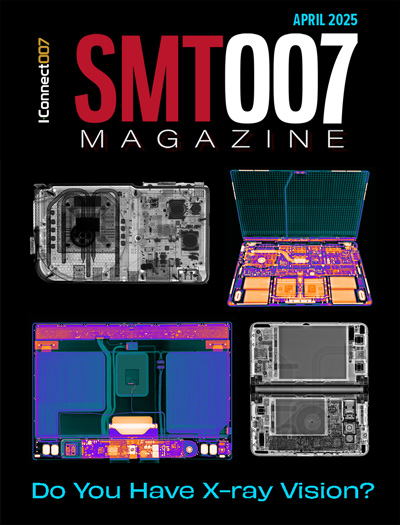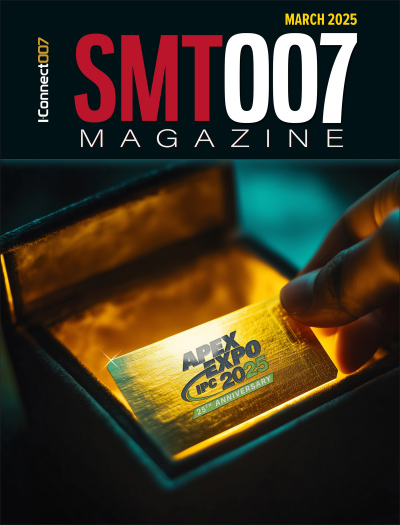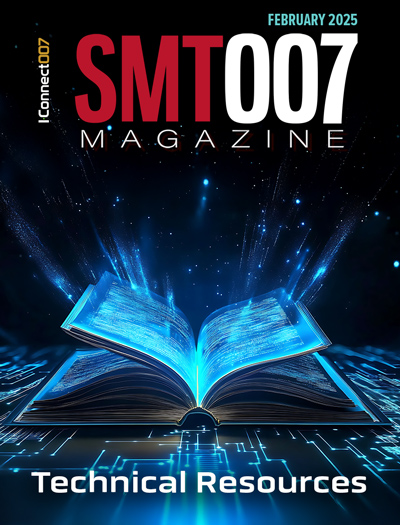-

- News
- Books
Featured Books
- smt007 Magazine
Latest Issues
Current Issue
Do You Have X-ray Vision?
Has X-ray’s time finally come in electronics manufacturing? Join us in this issue of SMT007 Magazine, where we answer this question and others to bring more efficiency to your bottom line.

IPC APEX EXPO 2025: A Preview
It’s that time again. If you’re going to Anaheim for IPC APEX EXPO 2025, we’ll see you there. In the meantime, consider this issue of SMT007 Magazine to be your golden ticket to planning the show.

Technical Resources
Key industry organizations–all with knowledge sharing as a part of their mission–share their technical repositories in this issue of SMT007 Magazine. Where can you find information critical to your work? Odds are, right here.
- Articles
- Columns
Search Console
- Links
- Media kit
||| MENU - smt007 Magazine
Seeing Clearly: XR Headsets and Flex’s Reference Design at AWE
June 26, 2018 | Dan Feinberg, Technology Editor, I-Connect007Estimated reading time: 5 minutes
At the recently concluded Augmented World Expo (AWE) in Santa Clara, California, Flex invited I-Connect007 to attend an event where they presented an update on their XR progress since the Consumer Electronics Show (CES) in January in Las Vegas, Nevada. At this year’s CES, they announced the launch of an extended reality (XR) reference design for the next generation of XR headsets. As the “sketch-to-scale” solutions provider, as they describe themselves, that designs and builds “intelligent products for a connected world,” they have now introduced an augmented reality (AR or, as we now call it, XR) reference design to reduce time to market for companies wishing to make and market XR devices.
As we increase our coverage of megatrends, and because we consider XR to be one of the more interesting and growing industry segments, we were happy to attend AWE. In doing so, we gained significant insight into the development process used by Flex for this segment.
The Flex AR reference design is a complete, virtually market-ready product specification, including a head-mounted display (HMD), an external processing unit (EPU), and a gesture-based software interface to manage interaction between the virtual world and the hardware. A company wishing to enter the XR market can use the Flex AR reference design instead of developing their own AR hardware. Companies can make modifications and tweaks to the reference design, but by using what is now available from Flex, they would significantly reduce product development costs and quickly scale manufacturing. Basically, once they have decided to do so, they can quickly and economically enter the market with a quality system.
In addition, by using a reference design from a company such as Flex, companies can avoid the challenge of assembling a team of experts in hardware, design, optics, and thermal issues. While many companies may have such a team, others may not have enough experts to enable the design in a timely manner. In addition, many may not have the resources for their teams to design state-of-the-art human machine interfaces (HMIs) or head-up/head-mounted displays (HUDs or HMDs). This may be true for anyone wishing to enter or expand into a new market, but it may be especially true for a startup or skunkworks project at a larger company. If this is the case, it is probable that a reference design could give you a leg up in a rapidly advancing area of technology—what isn’t rapidly advancing these days—and make the difference between success or failure due to being a little late to market with a design slightly past its prime.
While this all makes sense, a company considering market entry or a next-generation product announcement has to ask about using a reference design as a foundation: “Is this platform significant enough to allow us to compete in the areas of performance, usability, and quality?” After listening to Flex and their key partners in this endeavor—Qualcomm, Atheer, and Lumus—and having a chance to see the product, ask questions, actually use the resultant reference hardware, and mentally compare it to others I have used in the last few months based on usability, comfort, response, and quality, my opinion is yes, Flex’s platform does allow for these things.
Now, let me describe the Flex reference design and the features and abilities available to companies entering or looking to expand into the XR megatrend as presented to us by Eric Braddom, VP of XR solutions for Flex, Amar Dhaliwal, senior VP of marketing and sales for Antheer, Sivan Iram, VP of business development for Lumus, and Patrick Costello, senior director of business development at Qualcomm.
The Flex XR reference platform incorporates cutting-edge technology from its partners, including the Snapdragon 835 mobile platform from Qualcomm, designed to deliver full-color, high-definition 1080p AR experiences. The Snapdragon 835 draws 25% less power than previous models by using an advanced 10-nanometer design. Atheer Inc., a leading provider of AR solutions, supplies the AR interaction module and enterprise software support. The design also incorporates new OE Vision optics from Lumus, which is a high-resolution (1920 X 1080), top-down configured transparent display incorporating the most desired specs for advanced immersive AR headsets. Some highlights of the display include true see-through optics in a compact form factor showing lifelike images in full daylight conditions.
Using a reference design may be the best solution for any company looking to deploy a complete AR solution with minimal development costs and an accelerated time to market. It seems to be an option that any company planning to enter the XR market should consider.
Page 1 of 2
Suggested Items
Real Time with... IPC APEX EXPO 2025: Emerging Trends in Design and Technology
04/16/2025 | Real Time with...IPC APEX EXPOAndy Shaughnessy speaks with IPC design instructor Kris Moyer to discuss emerging design trends. They cover UHDI technology, 3D printing, and optical data transmission, emphasizing the importance of a skilled workforce. The role of AI in design is highlighted, along with the need for understanding physics and mechanics as designs become more complex. The conversation concludes with a focus on enhancing math skills for better signal integrity.
Electronic System Design Industry Posts $4.9 Billion in Revenue in Q4 2024
04/15/2025 | SEMIElectronic System Design (ESD) industry revenue increased 11% to $4,927.3 million in the fourth quarter of 2024 from the $4440.9 million reported in the fourth quarter of 2023, the ESD Alliance, a SEMI Technology Community, announced in its latest Electronic Design Market Data (EDMD) report.
Connect the Dots: Involving Manufacturers Earlier Prevents Downstream Issues
04/16/2025 | Matt Stevenson -- Column: Connect the DotsIf you have read any of my earlier columns, you know I am passionate about helping designers design for the reality of manufacturing. Designing for manufacturability (DFM) is a team sport. DFM is a design process that looks forward to the manufacturing process and integrates with it so that manufacturing requirements and capabilities can be accurately reflected in the design work.
Global PCB Connections: The Next Wave of HDI PCBs– How Design Engineers Can Stay Ahead
04/17/2025 | Jerome Larez -- Column: Global PCB ConnectionsHigh density interconnect (HDI) printed circuit boards have come a long way from their origins as a niche technology for miniaturized applications. Today, HDI PCBs are at the forefront of innovation, driven by an insatiable demand for faster, smaller, and more powerful electronic devices. As consumer electronics, 5G infrastructure, and AI-driven systems advance, design engineers must stay ahead of the curve to ensure their PCB designs meet evolving industry demands.
Würth Elektronik ICS at PCIM Europe 2025
04/14/2025 | Wurth ElektronikWürth Elektronik ICS will be exhibiting at PCIM in Nuremberg from 6 to 8 May 2025. The specialist for PCB connection solutions in the high-current sector and inventor of Powerelements will be focussing on power electronics at exhibition stand 337 in hall A6.


